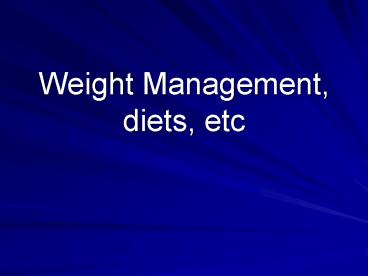Weight Management, diets, etc - PowerPoint PPT Presentation
1 / 27
Title:
Weight Management, diets, etc
Description:
... a person have a bowel movement. A diuretic increases amount of urine excreted ... Use of laxatives, diuretics, extreme exercise and vomiting are also common ... – PowerPoint PPT presentation
Number of Views:49
Avg rating:3.0/5.0
Title: Weight Management, diets, etc
1
Weight Management, diets, etc
2
WEIGHT MANAGEMENT!!
- Diet and exercise plan to achieve or maintain a
desirable weight and body composition.
3
- A weight management plan is based on caloric
intake and caloric expenditure.
How much do I take in versus how much do I burn?
4
What does it mean to be overweight or obese?
- Terms are not synonyms
- Overweight is body weight 10 or more than
desirable weight, obesity is 20 or more. - Both put you at risk for many illnesss and
disease
5
Weight loss strategies often tried
- Fad diets
- Liquid diets
- Prescription meds
- Over the counter diet pills
- Laxatives and diuretics
- Balanced diet and exercise!!!
6
Fad Diets
Approaches to weight control that are popular for
a short time, they come and go and rarely have a
lasting positive effect and sometimes have
lasting negative effects.
7
Liquid diets
- Beverages are substituted for some or all meals
- Some used under medical supervision some are not
- Some sold in supermarkets-provide few calories
and can be very dangerous
8
Prescription Meds
- An ANORETIC drug decreases appetite.
- Medical supervision required.
- Person must have physical examination, blood
tests and electrocardiogram - Some have been determined unsafe and individuals
need to be very cautious.
9
OTC diet pills
- Are purchased in drug stores, etc.
- Side effects include, anger, depression, rapid
pulse rate, sleeplessness, heart palpitations and
many more. - Can be dangerous, addictive, and ineffective
10
Laxatives and diuretics
- A laxative is a drug that helps a person have a
bowel movement. - A diuretic increases amount of urine excreted
- Can be VERY dangerous, and often just ridding
extra fluids, calories are still stored as fat
11
Losing weight starting a plan
- 1- TARGET YOUR WEIGHT-based on your body frame,
choose a healthy range. - 2-SET GOALS-losing .5-1LB a week is realistic.
- 3-MAKE A PERSONAL PLAN- include both a nutritious
eating plan and regular physical activity. Put in
WRITING!!
12
Some strategies.
Eat FEWER calories and burn more Calories through
exercise. Also eat nutrient dense foods and make
your portions smaller.
13
Eating disorders
- Mental disorder in which a person has a
compelling need to starve, to binge, or to binge
and purge. - BINGE-to eat large amounts of food over a short
amount of time - PURGE- rid the body of food by vomiting or using
laxatives
14
Anorexia Nervosa
- Eating disorder involving self starvation
- Use of laxatives, diuretics, extreme exercise and
vomiting are also common - OBSESSION with being thin and do not recognize it
when they have become dangerously thin
15
Health consequences
- Dehydration,constipation,nausea
- Hair loss
- Hormonal changes
- Damage to heart, kidneys, and other major organs
- Impaired immune system
- Absence of menstruation in females
16
- Without treatment, 10 percent of people with
anorexia nervosa will die. Other people will have
permanent damage to body organs. - People with anorexia may lack self respect,
withdraw from others, be at risk for suicide,
have bouts of depression.
17
(No Transcript)
18
- Treatment-
- Involves a team of professionals- physicians,
dieticians, and mental health professionals. - Hospital stays may be necessary to treat
malnutrition and dehydration - A treatment plan is developed that deals with the
individuals physical and emotional health problems
19
Bulimia
- Eating disorder in which a person binges and
purges - Usually vomit or use laxatives or diuretics to
purge. Bulimia is more common than anorexia - Binge-purge cycle dominates their lives
- Unlike people with anorexia, many times people
with bulimia know they have a problem
20
(No Transcript)
21
(No Transcript)
22
Treatment for bulimia
- Difficult to diagnose because many people who
suffer from it are successful at hiding their
behaviors. - Tests are done to assess body organ damage
- Repair usually needs to be done to treat gums and
repair teeth. - Serious treatment plans and hospitalization may
be implemented.
23
Other eating disorders.
- Binge-eating disorder
- A person can not control eating and eats
excessive amounts - Cannot resist urge to eat when food is in sight
- Turn to food as substitute for coping
- Skeletal difficulties, increased blood pressure,
and diabetes are just a few of the risks
24
WHY?
- Why some youth are at risk for eating disorders?
- Body image- a persons perception of their body
appearance - Body image distortion may be developed which is
an inaccurate visual perception of ones body - May be caused by the portrayal of teens in tv
shows and magazines
25
- Perfectionism-
- Compelling need to do everything perfectly
- Need for control
- Inability to express emotions
26
Some signs.
- Constantly compare themselves with others
- Being unhappy with physical appearance
- Wearing baggy clothes
- Never being satisfied with anything they do
- Excessive exercising, starving themselves
- Feeling secure only when in control.
27
(No Transcript)































